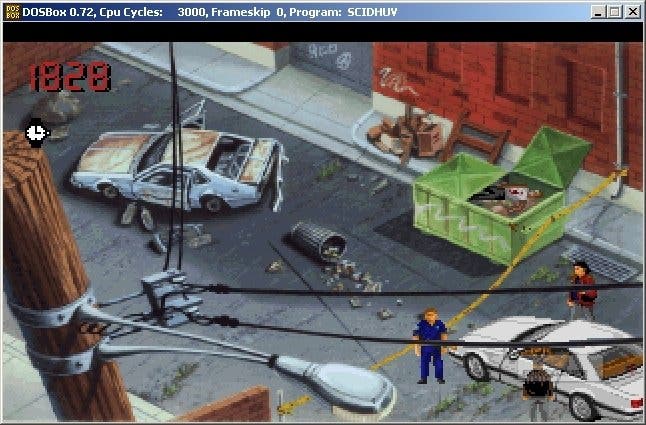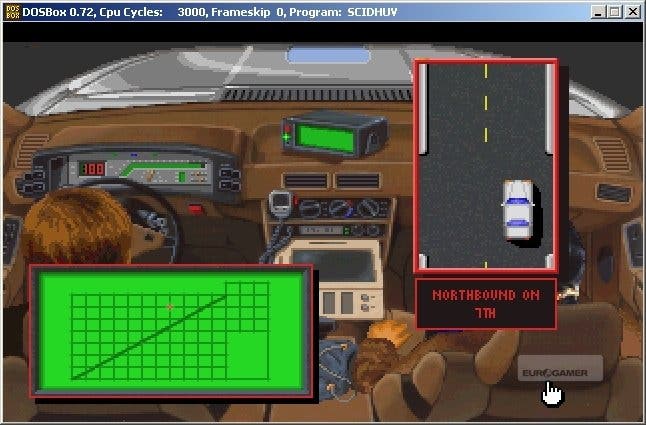Retrospective: Police Quest III: The Kindred
Violation #395.7: Clicking on a review link without clear signal.
When you think Halloween you might not immediately think Police Quest III. In fact, when asked to name a classic adventure game there's a fairly good chance this would appear far down most people's lists. Further, I wonder how many people now even know that the long-running Vivendi SWAT series began as four point-and-click adventures?
Police Quest in fact reaches back as far as 1987, when the original parser-based adventure was made by Sierra in collaboration with ex-police officer Jim Walls. Aiming to create something more realistic the game followed Walls' own real-life experiences, as well as strict police procedure. Police officer Sonny Bonds begins as a traffic cop, but soon finds himself working a homicide case involving drug dealer Jessie Bains.
The second game followed the same motifs, with Bains having escaped from prison and after Bonds and his girlfriend Marie. (Scandalously, Marie was a prostitute in the first game who had aided Bonds.) This time the procedure and realism is ramped up to a ludicrous degree. By Police Quest III: The Kindred, Bains is dead, Sonny and Marie are married, and despite being promoted to Sergeant he finds himself back on traffic duty at the start.

You need to put PQ3 in context to understand its decisions. This was made in 1991, using Sierra's brand new SCI (Sierra's Creative Interpreter) language. Now fully mouse-controlled, it used the cycling cursors for interaction, and suddenly the designers felt free to try so many more ideas. Ideas that, arguably, the tech wasn't quite ready for. Such as the driving.
But even before that the game underlines its tone. The first task you must complete is filing the correct form with the correct person to receive your computer access card, in order that you can later appropriately file reports on your PC. While this may become a game about serial killers, stabbings and corruption, it's never not a game about remembering to do your paperwork. It's perhaps this that the Police Quest games are derisively remembered for today, but it's a reputation that I think is unfair, not only because they did so much more, but because doing it at all was a really good idea. Just perhaps not executed as well as it might have been.
But the driving. The city over which you have jurisdiction, Lytton, is about 13 by eight blocks, diagonally intersected by a highway. To negotiate it you sit behind the wheel, turn on the ignition, and then watch your car on a top-down insert with about six-foot of asphalt visible in front of you. You navigate with a combination of a near-useless second insert, a digital grid of the city, and the manual's map, taking turns at the right moment and then inevitably cranking the speed up to 100mph to try to make it be over more quickly. The game begins with so much of it, and it ends with even more, and there's far too much of it in-between. And it adds absolutely nothing to the experience. Well, perhaps apart from the earliest moments of traffic patrol, and then only if you remember to do it.

If you persist with ploughing up and down the highway you'll be asked to pull over a number of vehicles for various violations. Without being given any warning you must note down the time that briefly appears on screen, then speak to the driver (approaching from the near side, or you'll be run over instantly), and then apply the correct procedure for the circumstances. If he's speeding, run his licence in your car's on-board computer, then issue him a ticket. Drunk driving? Perform a roadside sobriety test, make an arrest, and take him back to the jail. Where you must correctly submit his possessions, make him take breathalyser, and then put him in the clink. SWAT 4 it is not.
However, should you steer off the highway at any point you might miss all of this. Which means you'll miss pissing off a rather unpleasant gentleman by the name Ruiz, who will later take you to court and open up all sorts of other details. Much is made of games with multiple pathways today, but gosh, Sierra was doing it way back when.
The game proper begins when Bonds' wife is near-fatally stabbed in a parking lot outside a mall, which means - magnificently strangely in a game otherwise obsessed with proper behaviour - you're put straight back into Homicide and told to find the attackers.

And here's why I remember this game so fondly, despite its litany of ludicrous ways. It felt like, in a way that I wouldn't experience again until the almost completely forgotten but wonderful Spycraft: The Great Game in 1996, you were actually investigating. By examining old cases in the computer's records you discover a similar crime, and then another, and begin to piece together the actions of a serial killer.
Another murder occurs which you and your partner Morales investigate, and from this you realise the pattern that's developing. On top of that in the memory department is the graphics. They're a confusing mixture of hand-painted backgrounds, hand-drawn characters, and crudely cropped and animated photographs. But it was those photographs that had my jaw dropping back then. As ridiculous as that seems now. They were REAL PEOPLE!

